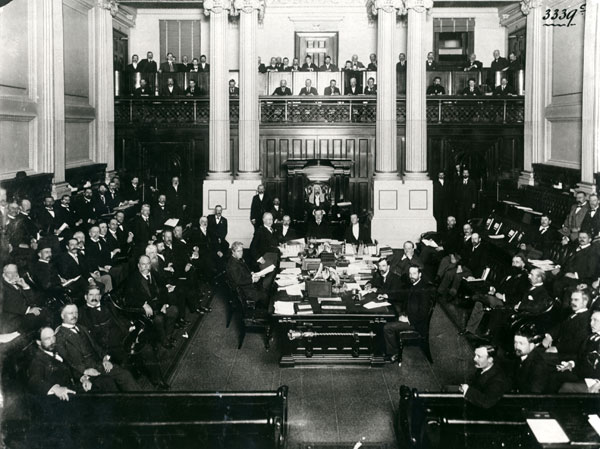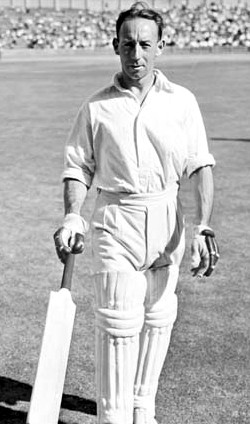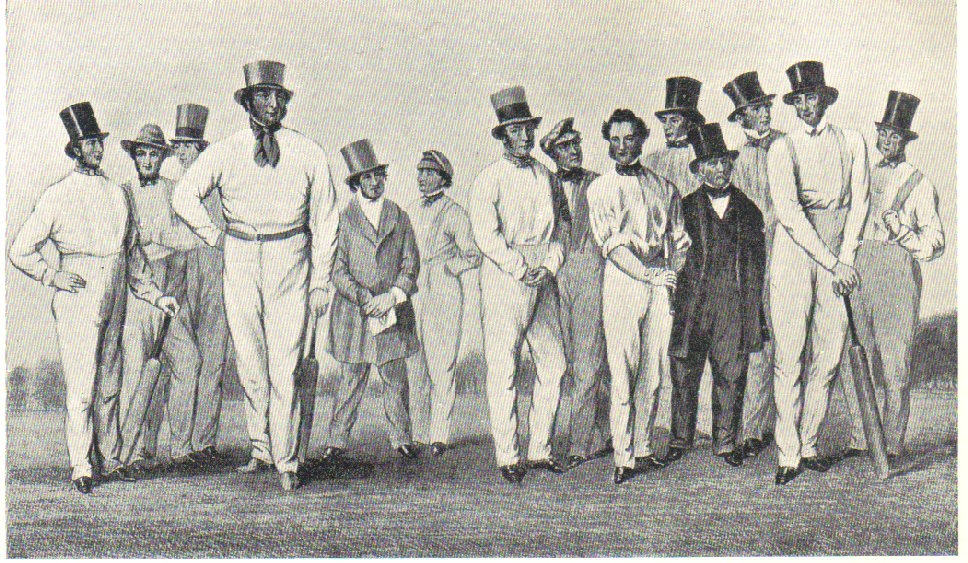 |
Don Bradman
Sir Donald George Bradman, (27 August 1908 – 25 February 2001), nicknamed "The Don", was an Australian international cricketer, widely acknowledged as the greatest batsman of all time. Bradman's career Test cricket, Test batting average (cricket), batting average of 99.94 has been cited as the greatest achievement by any sportsman in any major sport. The story that the young Bradman practised alone with a stump (cricket), cricket stump and a golf ball is part of Australian folklore. His meteoric rise from The Bush, bush cricket to the Australian national cricket team, Australian Test team took just over two years. Before his 22nd birthday, he had set many records for top scoring, some of which still stand, and became Australia's sporting idol at the height of the Great Depression in Australia, Great Depression. During a 20-year playing career, Bradman consistently scored at a level that made him, in the words of former Australia captain Bill Woodfull, "worth three batsmen ... [...More Info...] [...Related Items...] OR: [Wikipedia] [Google] [Baidu] |
|
Cootamundra
Cootamundra, nicknamed Coota, is a town in the South West Slopes region of New South Wales, Australia and within the Riverina. It is within the Cootamundra-Gundagai Regional Council. At the 2016 Census, Cootamundra had a population of 6,782. It is located on the Olympic Highway at the point where it crosses the Muttama Creek, between Junee and Cowra. Its railway station is on the Main Southern line, part of the Melbourne-to-Sydney line. Cootamundra is the birthplace of Sir Donald Bradman , an Australian cricketer universally regarded as the greatest batsman of all time. It is also known for being the site of Cootamundra Domestic Training Home for Aboriginal Girls, an institution housing Aboriginal girls who were forcibly taken from their families. It is also the home of the Cootamundra wattle. Every year there is a large "Wattle Time" Festival held at the time the wattle starts to bloom, with an art show and festivities. History The traditional owners of the area ... [...More Info...] [...Related Items...] OR: [Wikipedia] [Google] [Baidu] |
|
 |
The Bush
"The bush" is a term mostly used in the English vernacular of Australia and New Zealand where it is largely synonymous with ''backwoods'' or '' hinterland'', referring to a natural undeveloped area. The fauna and flora contained within this area must be indigenous to the region, although exotic species will often also be present. The Australian and New Zealand usage of the word "bush" for "forest" or scrubland, probably comes from the Dutch word "bos/bosch" ("forest"), used by early Dutch settlers in South Africa, where it came to signify uncultivated country among Afrikaners. Many English-speaking early European settlers to South Africa later migrated to Australia or New Zealand and brought the term with them. Today, in South Africa Fynbos tends to refer to the heath vegetation of the Western Cape and Eastern Cape. It is also widely used in Canada to refer to the large, forested portion of the country. The same usage applies in the US state of Alaska. History Indigeno ... [...More Info...] [...Related Items...] OR: [Wikipedia] [Google] [Baidu] |
|
ICC Cricket Hall Of Fame
The ICC Cricket Hall of Fame recognises "the achievements of the legends of the game from cricket's long and illustrious history". It was launched by the International Cricket Council (ICC) in Dubai on 2 January 2009, in association with the Federation of International Cricketers' Associations (FICA), as part of the ICC's centenary celebrations. The initial inductees were the 55 players included in the FICA Hall of Fame which ran from 1999 to 2003, but further members are added each year during the ICC Awards ceremony. The inaugural inductees ranged from W. G. Grace, who retired from Test cricket in 1899, to Graham Gooch, who played his last Test match in 1995. Living inductees receive a commemorative cap; Australian Rod Marsh was the first member of the initial inductees to receive his. Members of the Hall of Fame assist in the selection of future inductees. South African Barry Richards played the fewest Test matches during his career with four, before South Africa w ... [...More Info...] [...Related Items...] OR: [Wikipedia] [Google] [Baidu] |
|
|
Royal Australian Mint
The Royal Australian Mint is the sole producer of all of Australia's circulating coins and is a Commonwealth Government entity operating within the portfolio of the Treasury. The Mint is situated in the Australian federal capital city of Canberra, in Denison St, in the suburb of Deakin. The Mint was opened in 1965 by Prince Philip, Duke of Edinburgh. Before the opening of the Australian Mint, Australian coins were struck at the Sydney Mint, Melbourne Mint and Perth Mint. As such, the Royal Australian Mint was the first mint in Australia to be independent of the British Royal Mint, in the United Kingdom, which was a British government entity. (Of the three older Australian mints, only Perth Mint has remained; it was a subsidiary of the UK Royal Mint until 1970.) Foundations and history Planning for the mint started in 1959 when it was proposed to move the Melbourne branch of the Royal Mint to Canberra, with a large site in the Canberra suburb of Deakin chosen. The Chief D ... [...More Info...] [...Related Items...] OR: [Wikipedia] [Google] [Baidu] |
|
|
International Cricket Hall Of Fame
The Bradman Museum & International Cricket Hall of Fame is a permanent cultural exhibition dedicated to the game of cricket. It is located in the Australian town of Bowral, New South Wales. The exhibition opened in November 2010 in buildings formerly used by the Bradman Museum, which was devoted to the cricketing career of the Australian batsman Sir Donald Bradman. The Bradman Museum opened in 1989. The Hall of Fame incorporated all of the former Bradman Museum's holdings. The International Cricket Hall of Fame is adjacent to Bradman Oval, which was named after him in 1947, and, as the Glebe Oval, was where he played many games in his early years, and where his and his wife's ashes are now scattered. The oval and museum are tourist attractions for cricket fans in Australia, and for people visiting from overseas. In 2016, after the ODI win over India in Manuka Oval, Canberra, on their way to Sydney Cricket Ground The Sydney Cricket Ground (SCG) is a sports stadium in Sydne ... [...More Info...] [...Related Items...] OR: [Wikipedia] [Google] [Baidu] |
|
 |
John Howard
John Winston Howard (born 26 July 1939) is an Australian former politician who served as the 25th prime minister of Australia from 1996 to 2007, holding office as leader of the Liberal Party. His eleven-year tenure as prime minister is the second-longest in history, behind only Sir Robert Menzies, who served for eighteen non-consecutive years. Howard was born in Sydney and studied law at the University of Sydney. He was a commercial lawyer before entering parliament. A former federal president of the Young Liberals, he first stood for office at the 1968 New South Wales state election, but lost narrowly. At the 1974 federal election, Howard was elected as a member of parliament (MP) for the division of Bennelong. He was promoted to cabinet in 1977, and later in the year replaced Phillip Lynch as treasurer of Australia, remaining in that position until the defeat of Malcolm Fraser's government at the 1983 election. In 1985, Howard was elected leader of the Liberal Par ... [...More Info...] [...Related Items...] OR: [Wikipedia] [Google] [Baidu] |
 |
Prime Minister Of Australia
The prime minister of Australia is the head of government of the Commonwealth of Australia. The prime minister heads the executive branch of the Australian Government, federal government of Australia and is also accountable to Parliament of Australia, federal parliament under the principles of responsible government. The current prime minister is Anthony Albanese of the Australian Labor Party, who became prime minister on 23 May 2022. Formally appointed by the Governor-General of Australia, governor-general, the role and duties of the prime minister are not described by the Constitution of Australia, Australian constitution but rather defined by Constitutional convention (political custom), constitutional convention deriving from the Westminster system. To become prime minister, a politician should be able to Confidence and supply, command the confidence of the House of Representatives (Australia), House of Representatives. As such, the prime minister is typically the leader o ... [...More Info...] [...Related Items...] OR: [Wikipedia] [Google] [Baidu] |
 |
Australian Cricket Team In England In 1948
The Australian cricket team in England in 1948 is famous for being the only Test match side to play an entire tour of England without losing a match. This feat earned them the nickname of "The Invincibles", and they are regarded as one of the greatest cricket teams of all time. According to the Australian federal government, the team "is one of Australia's most cherished sporting legends". The team was captained by Don Bradman, who was making his fourth and final tour of England. Including five Test matches, Australia played a total of 34 matches, of which 31 were first-class, between 28 April and 18 September. Two of the non-first-class matches were played in Scotland. They had a busy schedule, with 112 days of play scheduled in 144 days, meaning that they often played every day of the week except Sunday. Their record in the first-class games was 23 won and 8 drawn; in all matches, they won 25 and drew 9; many of the victories were by large margins. They won the Test serie ... [...More Info...] [...Related Items...] OR: [Wikipedia] [Google] [Baidu] |
 |
World War II
World War II or the Second World War, often abbreviated as WWII or WW2, was a world war that lasted from 1939 to 1945. It involved the World War II by country, vast majority of the world's countries—including all of the great powers—forming two opposing military alliances: the Allies of World War II, Allies and the Axis powers. World War II was a total war that directly involved more than 100 million Military personnel, personnel from more than 30 countries. The major participants in the war threw their entire economic, industrial, and scientific capabilities behind the war effort, blurring the distinction between civilian and military resources. Air warfare of World War II, Aircraft played a major role in the conflict, enabling the strategic bombing of population centres and deploying the Atomic bombings of Hiroshima and Nagasaki, only two nuclear weapons ever used in war. World War II was by far the List of wars by death toll, deadliest conflict in hu ... [...More Info...] [...Related Items...] OR: [Wikipedia] [Google] [Baidu] |
 |
England Cricket Team
The England cricket team represents England and Wales in international cricket. Since 1997, it has been governed by the England and Wales Cricket Board (ECB), having been previously governed by Marylebone Cricket Club (the MCC) since 1903. England, as a founding nation, is a Full Member of the International Cricket Council (ICC) with Test, One Day International (ODI) and Twenty20 International (T20I) status. Until the 1990s, Scottish and Irish players also played for England as those countries were not yet ICC members in their own right. England and Australia were the first teams to play a Test match (15–19 March 1877), and along with South Africa, these nations formed the Imperial Cricket Conference (the predecessor to today's International Cricket Council) on 15 June 1909. England and Australia also played the first ODI on 5 January 1971. England's first T20I was played on 13 June 2005, once more against Australia. , England have played 1,058 Test matches, winning 387 an ... [...More Info...] [...Related Items...] OR: [Wikipedia] [Google] [Baidu] |
 |
Bodyline
Bodyline, also known as fast leg theory bowling, was a cricketing tactic devised by the English cricket team for their 1932–33 Ashes tour of Australia. It was designed to combat the extraordinary batting skill of Australia's leading batsman, Don Bradman. A bodyline delivery was one in which the cricket ball was bowled, at pace, at the body of the batsman in the expectation that when he defended himself with his bat a resulting deflection could be caught by one of several fielders standing close by on the leg side. Critics of the tactic considered it intimidating and physically threatening in a game that was traditionally supposed to uphold conventions of sportsmanship. The England team's use of the tactic was perceived by some, both in Australia and England, as overly aggressive or even unfair, and caused controversy that rose to such a level that it threatened diplomatic relations between the two countries before the situation was calmed.Frith, pp. 241–59. Althoug ... [...More Info...] [...Related Items...] OR: [Wikipedia] [Google] [Baidu] |